The origin of street art is as mysterious and obscured as the people who create it. Historians have traced its roots back to the 1st century B.C.E. when Roman citizens scribbled messages to each other on the dry brick walls. Yet, it wasn’t until the French Revolution’s iconoclasm era, when rebels defaced high-end art to stage a protest against French society’s toxic hierarchy, that graffiti took on the “vandalism” label it holds today. Since then, the rise of street art around the world has mirrored multiple waves of political unrest. One of the most iconic examples of political street art is the Berlin Wall’s one-sided graffiti, a public and tangible fight of expression versus totalitarianism. Vibrant images of love and desire colored one side of the wall, while the other stood grey and silent.
The use of this avant-garde art style for political activism has spread to the extent of my home in the Bay Area, California. Over time, as an influx of White upper-class residents displaced low-income households, the anger of local Bay Areans fueled a movement to take back the streets via spray paint, video projections, wheatpasting, and stenciling — any street art medium requiring some degree of guerrilla operations. Most recently, following the murder of George Floyd and other Black community members, cities have broken into protests and are driving crucial momentum for the Black Lives Matter movement. Bay Area activists are taking part by weaponizing street art to unite the masses and reclaim their communities’ stolen narratives, re-imagining better futures alongside comrades across the nation. Their freeing and colorful art combats the virulent systems of oppression that white supremacy has entrenched in our society, those same systems which mark their craft as illegal under the guise of vandalism.
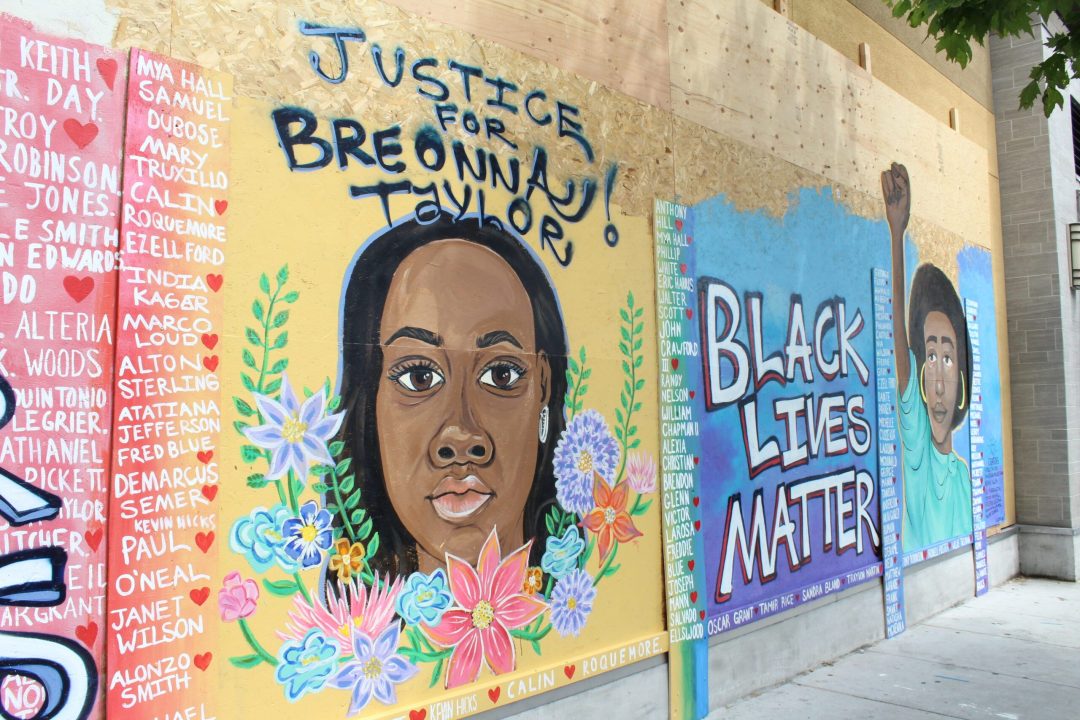
Black Lives Matter and Justice for Breonna Taylor mural drawn on College Avenue in Berkeley, California. Artist unknown.

George Floyd’s name covers the columns of the Pergola at Lake Merritt in Oakland, California.
The High-End Art World
In the 1970s, graffiti artists in America successfully unionized for the first time. Taken aback, the wealthy responded by carefully choosing only certain graffiti artists to amplify. They opened up the high-end art world selectively, incentivizing the creation of street art for the sole purpose of earning money within the curated spaces set up by the elite. The unions eroded as a consequence of this system, with infighting and poorly hidden resentment eating away at their core.
The system hasn’t changed since the ‘70s; the present-day continuation of excluding non-male and non-White artists from museums and the wealth associated with high-end art is no coincidence. According to a recent Data USA study, 85.4% of archivists, curators, and museum technicians are White. The next most common ethnicity (Hispanic White) clocks in at a mere 5%. These statistics highlight the high-brow art world as just another example of the White and wealthy excluding those who do not “fit in” with them. There’s an iconic line from the movie Molly’s Game, where an art collector confides that “the art world is controlled by a few major dealers. They alone control the market. They choose the artists they want to be important.” And those valued artists are predominantly White men, with 85.4% of works in all major US museums belonging to White artists, 87.4% by men.
Additionally, due to a lack of public funding, museums and galleries are forced to rely on the wealthy patrons sitting on their executive boards to influence what art is “worthy” for public display. At the Whitney Museum, for example, trustees must pay a steep annual fee of $200,000 to stay in power. Moreover, in October 2019, a New York Times analysis found that 40% of museum trustees are Wall Street tycoons — showing that control over the high-end art world is not merely determined by if a trustee is wealthy, but also where they derive their wealth from.
Street artists could not be more different demographically than the über-rich who control who enters and exits their curations. If you are a street artist, there’s a higher chance of you being low-income, a person of color, female, or part of the LGBTQIA+ community. Whether street artists began as a group of creative minorities, or if the restrictive high-end art world forced them to become the demographic that they are today mirrors the chicken or the egg dilemma. Because the exclusion of minorities from the art world perpetuates the diverse demographics of street artists, street art is a necessary foil to an elite, hyper-capitalist art world that stifles creativity and identity. Given graffiti’s positionality in this sense, the mere creation of a piece of street art can be seen as an act of resistance against the hierarchical high-end art world.

“The Marathon Continues,” a Nipsey Hussle mural located in Oakland and painted by Timothy Bluitt (@timothyb_art).
Sharing Stories Silenced Before
If the White and the wealthy do not want certain stories to be told, then street art is the best way to resist and put those messages out there. Tired after years of high-end art’s systemic silencing and oppression, Black and Brown artists have been turning to street art to explore their identities as people of color.
For activists like Nancypili Hernandez, street art is a crucial tool in telling suppressed stories. In the past 10 years, Hernandez has created and directed many different murals, working in San Francisco’s Latinx community to “document people’s history that isn’t told in the history books.” Her work in the Mission District, a historically gentrified neighborhood, highlights the struggles of the Latinx residents, amplifying the stories of a native community passed over by San Francisco’s tour guides. Street art is doing the generational lifting that history failed to carry.
DeVante Brooks, born and raised in Oakland, is doing the same. Recognizing the need to take ownership of his lost voice and facing his identity as a Black man, he reflects on what it means to be an artist. With the escalation of the Black Lives Matter movement, he’s found power in painting large murals on Broadway Street, one of the busiest avenues in Oakland. “I want to target young Black men who grew up like I did,” he explains. “[I had] no real strong kind of father figure to guide me. If you feel like you can help someone get through their day with your artwork, put it out there. Someone might want to see it, or they might need it, and that will push them to do something great.”
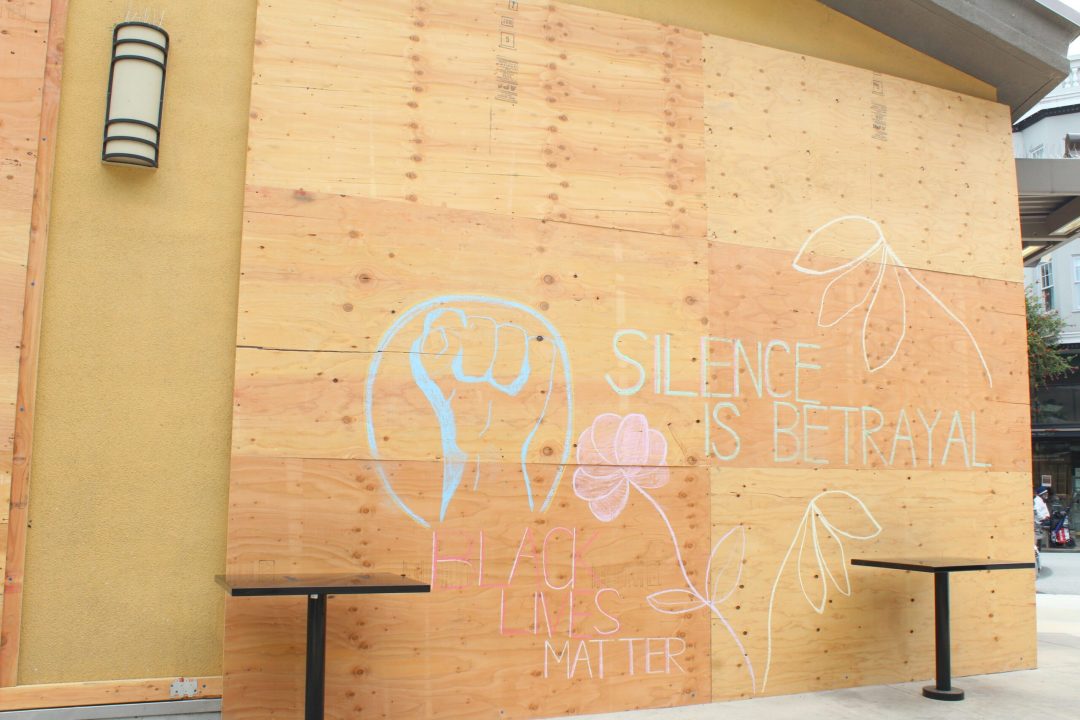
A blue Black Power fist is drawn in chalk next to Philz Coffee in Berkeley. This photo was taken by David Batcayar.

A large Black Lives Matter graffiti serves as a backdrop for two cars parked in Oakland.
Beyond telling stories lost in the ebbings of time, street artists also help create new ones. By recruiting members of rival gangs to work on murals together, Hernandez uses art to lay “common ground to stand on.” Her street art brings people together, not just through the final product, but via its ideation. “The process is what we’re teaching, to work together,” Hernandez says. Street artists are teaching the next generation how to build community and to fight for people that they may not necessarily know. The act of painting together is a healing act, a tool for collective liberation.
In fact, the more you dig into street art, the more you find it’s less about the product and more about the deep connection between art and people. In 2017, Polish street artist Olek crocheted a colorful costume for a statue in the middle of a square in her Polish hometown. At night, two teenage boys came by and angrily tore it down completely. Olek says that while she first felt anger, she ultimately wanted to help the boys grow. She set them to work crocheting scarves for the homeless in their locale, teaching them how art can be transformative and healing. “That was the real art,” she claims. “The process, the reaction. How people perceive things and how they grow from it.” Mona Caron, a Swiss muralist known for her multi-story floral street art, agrees. She describes her pieces as “Trojan horses,” detailing how she draws people in with her art’s beauty and then delivers a message.

Light chalk on the boarded up walls of Philz Coffee on College Avenue, captured by David Batcayar.
Decriminalizing Art
However, street art is quickly dismissed as “vandalism” and illegal activity when not in private galleries. Brooks explains that “there’s an automatic stigma [around street art] because it’s so closely associated with Black and Brown communities.” Passerbys repeatedly call the cops on street artists, immediately racial profiling and assuming the worst. This kind of racism is common in every aspect of life for people of color, especially in wealthier neighborhoods with White residents. Such prejudice extends to street art to such an extent that the act of creating graffiti itself has become an act of resistance against those who wish to suppress and police these diverse voices.
The primary argument of those who oppose public street art, telling artists they should resort to “legal” methods of art in the privacy of their homes, ignores the glaring fact that the high-end art world is discriminatory. Yet, corporations have weaponized this logic to maintain control over the status quo. Keep America Beautiful, a large non-profit with corporate sponsors like H&M, PepsiCo, and McDonalds, began a program in 2007 called Graffiti Hurts, offering grants upwards of $2,000 to local governments and police departments for fighting street art. Their slogan? “We keep America beautiful so Americans can do beautiful things.” The question stands — which Americans are given the right to create those “beautiful things?” And at whose expense?
While community members argue over what art is acceptable and what is unacceptable — as Hernandez puts it — “in any way you make art, the process of making art is not illegal.” If all art is sacred — as all acts of creation are — street art, especially, is sacred as it holds the unyielding narratives of humans who have been historically silenced. During the conception of a piece, the artist reflects on their self and re-acknowledges their identity. In this way, for artists of color, the process of reaffirming their identity through art stands contrary to a society that tells them their identity does not matter.
Brooks says that street artists shouldn’t be afraid to show their face doing something that they take pride in. “I’ve pretty much been judged the day since I was born,” he relates. “And if I keep letting that reign over me, I’m never going to truly live.” Existing as a BIPOC street artist is a rebellion in and of itself, and in turn, street art is a tool of civil disobedience.

A drawing of a young woman done in chalk stands over the words “Stop Mass Incarceration” on Philz Coffee’s boarded-up walls. This photo was taken by David Batcayar
Essential Businesses
With Black Lives Matter protests erupting in cities birthed from decades of gentrification, large corporations all around the country have responded by nailing plywood across their doors and massive windows.
Hernandez attributes this fear to the reversal of societal norms where “the People” decide which buildings are essential to their communities and “considered ours.” She points out that her neighborhood taqueria is still open while the fancy yoga studio is not. The Starbucks, Wells Fargo, and Walgreens were all looted — their glass smashed in, walls painted over — while small restaurants merely placed a “POC-owned” sign in their windows and were passed over. During peak protest time, large retailers like H&M, CVS, Target, and Nordstrom all announced temporary closures in response to looting and heavy protests. Yet, amidst the looting, numerous social media posts prompted activists to protect local businesses. This reclamation of minority communities against the effects of gentrification seems to be a consistent trend in cities with Black Lives Matter protests.
Artists of color, too, are publicly marking their judiciary, not just with shards of glass and setting property ablaze, but with layers of paint over the corporate doors. Intentionally targeting large chains that have infested their communities — elevating monthly rent and bringing in waves of affluent White neighbors — activists have covered storefronts with the names of those murdered at the hands of police, Black-power fists, and colorful, passionate art. “The People” Hernandez refers to are finally expressing themselves over the voices of transplants and greedy corporations. With spray paint and watercolor, they’re using street art to remind gentrifiers that they exist, that they’ve existed long before White hipsters and big retail chains overran their districts.
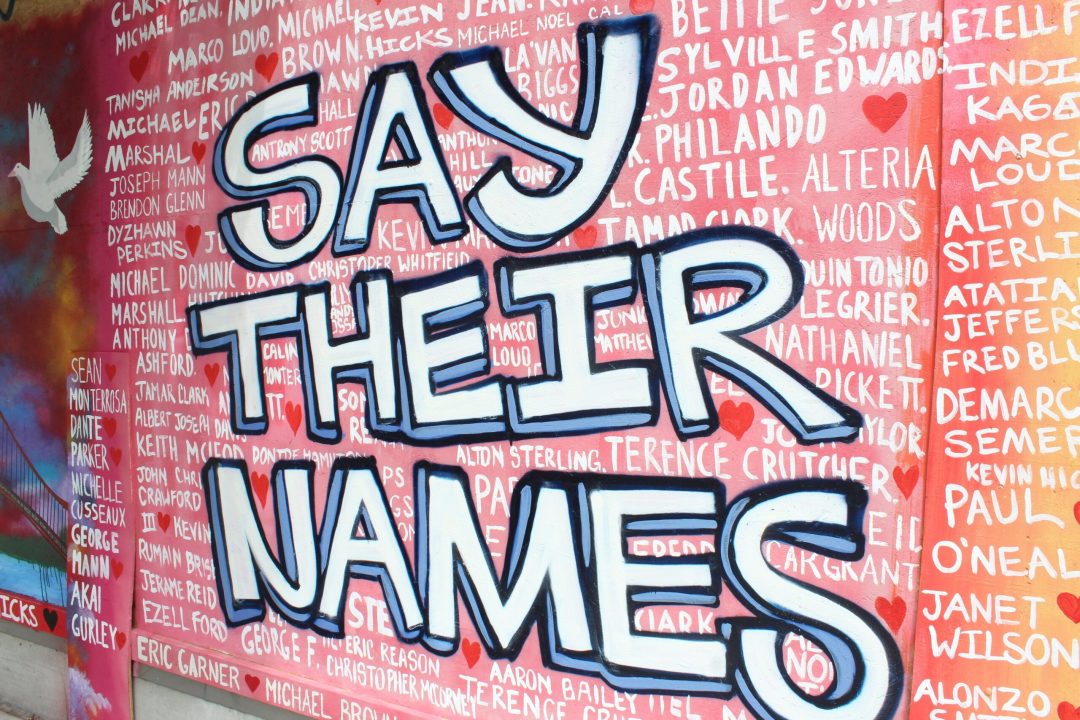
In Oakland, rows and rows of the names of murdered Black and Brown Americans are painted under a demand for people to “Say Their Names.”
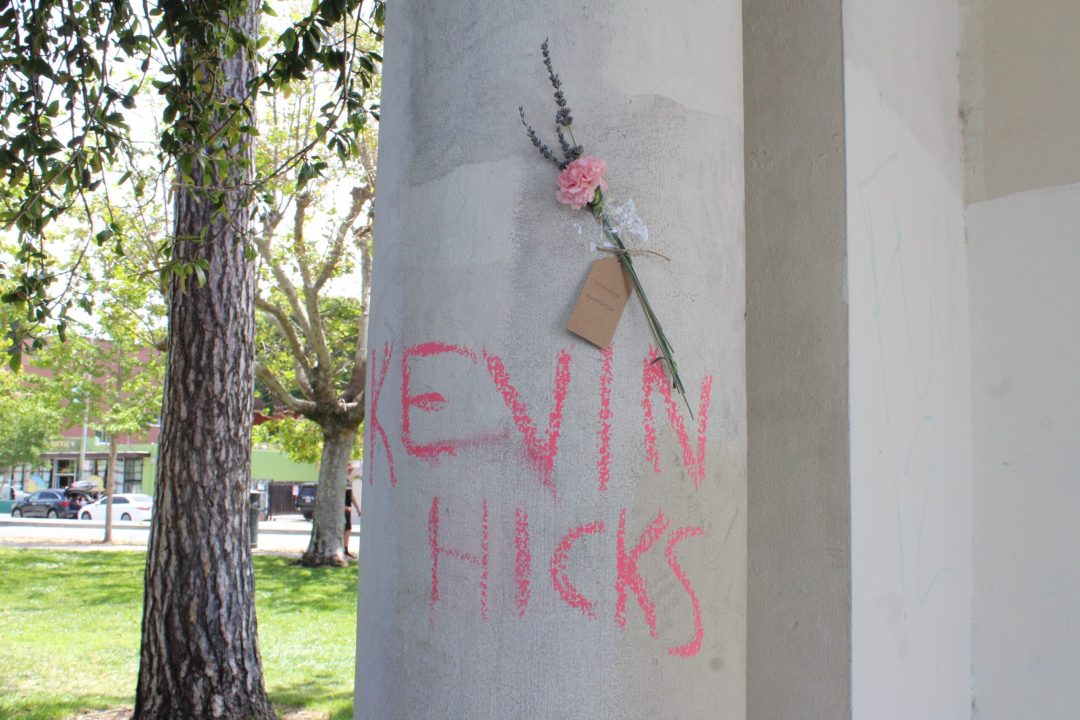
The name of murdered 16-year-old Kevin Hicks is scrawled on the column of Lake Merrit’s Pergola structure.

Timothy Bluitt (@timothyb_art) painted this mural in honor of Nia Wilson, an Oakland teenager murdered by a white man wielding a knife at the Rockridge BART Station. Nia’s throat was slashed, and her older sister Letifah stabbed in the neck — one of several examples of the murders of Black people on the BART station, the majority done by the police.
When asked about her recent projects, Olek says she’s put her art projects on hold, opting to join Black Lives Matter protests instead. “The protest itself is art,” she insists. This is a duality that echoes itself across all forms of street art: protest is art, and art is protest. It is hard to untangle the two from each other. The beauty of an amalgam of strangers banding together to fight for social justice evokes the same chilling inspiration that a massive Black Lives Matter mural might. Both protests and street art depend on being out in the public and accessible to anyone, and both are normally called together by marginalized communities. And while some street art may not appear political, when created by people dehumanized by the government, the politics are hard to avoid.
Caron agrees. To her, the significance of street art is that it is “publicly accessible to everyone and there’s no invisible barrier that keeps people of a certain class, and often, a certain race, outside of spaces.” Clearly a populist medium, street art democratizes public spaces and takes back the streets as effectively as physical protests. As a street artist, Hernandez says that her art transforms “locations that feel like a parking lot or private property, to feeling like a collective community commons.” Whereas before a space may have felt cold and distant, with the addition of familiar language and vibrant images, it feels like home once more. Street art makes people feel connected to a location and compelled to rediscover and make it sacred. In an age where gentrification has made local areas feel foreign, reclaiming space and rebirthing it as one for the people is essential.

A Maya Angelou quote is painted on a slab of wood nailed across a storefront in Oakland.
The Second Death
Yet, amidst all this glorious art and rebellion, there is an underlying fear of this tool of civil disobedience being taken away from those who need it most by the very force it has been combatting: gentrification. Caron sadly discusses what she calls “hipsterization,” explaining that once “you unload a truckful of street artists to make a whole neighborhood appear, somehow, more “cool,” this is the first step towards hipsterization and gentrification.” The longevity of street art as a form of protest seems to depend on whether artists of marginalized backgrounds can save graffiti culture from being co-opted by hipsters and capitalist curators.
Large marketing companies have already taken the iconic graffiti calligraphy and shoved it into branding to make products appear trendier. Perhaps the best-known street artist — and likely the only one you’ve been taught about in school — Banksy, a reportedly White, cis, male street artist, makes over $20 million a year off an art form that non-straight, low-income, people of color popularized. Street art, itself, is being gentrified.
Our society has taken everything else from marginalized communities. We cannot allow it to take street art, too. The gentrification of street art is a second death for the marginalized communities that have fought for equal rights, a blockade in the way of free expression and liberation.
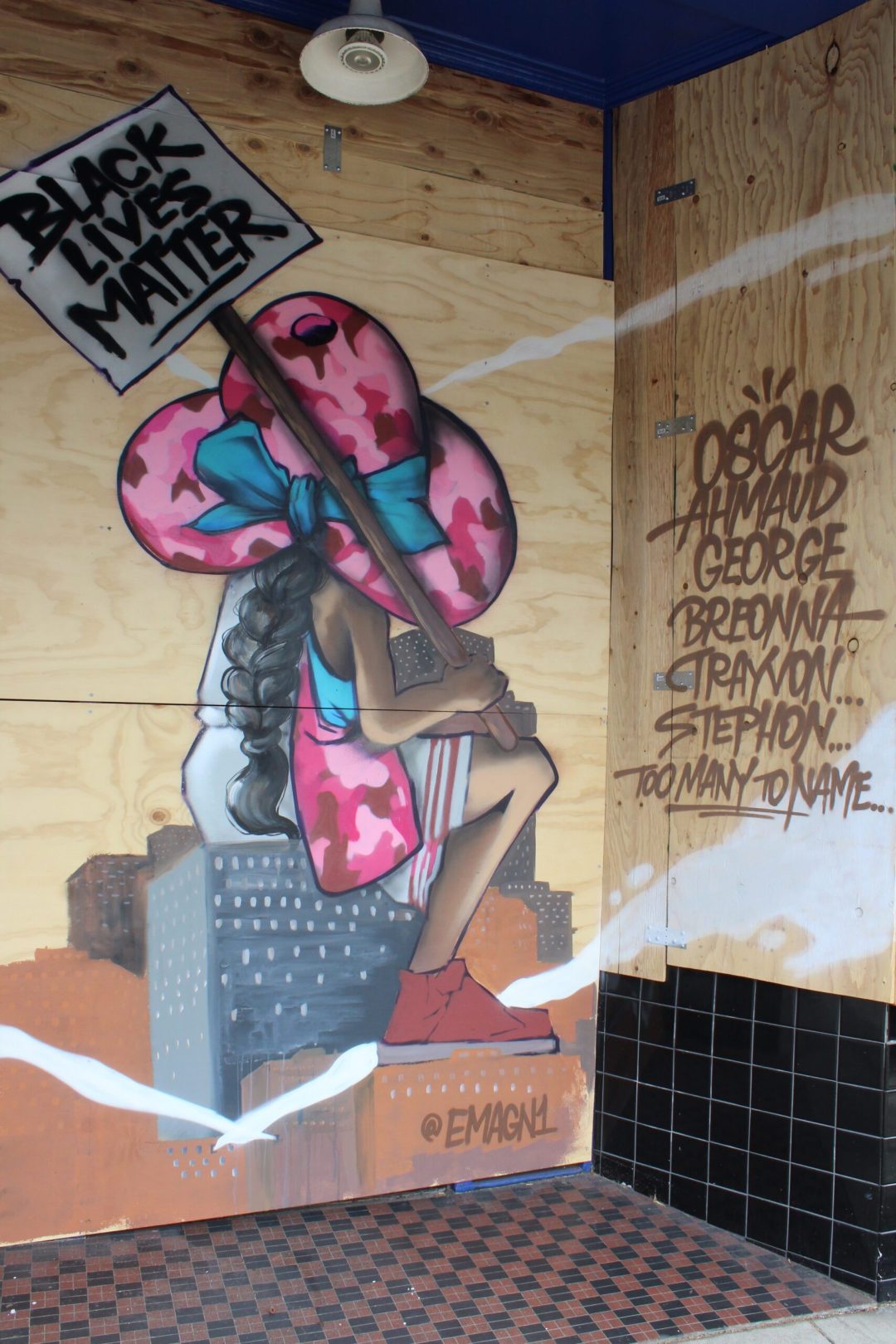
Artist Emagn Nation (@emagn1) names a few of the victims of police violence next to a large painting of a young girl holding a protest sign. This photo was taken in downtown Oakland.
Image Credit: Photos by Caroline Choi and David Batcayar
